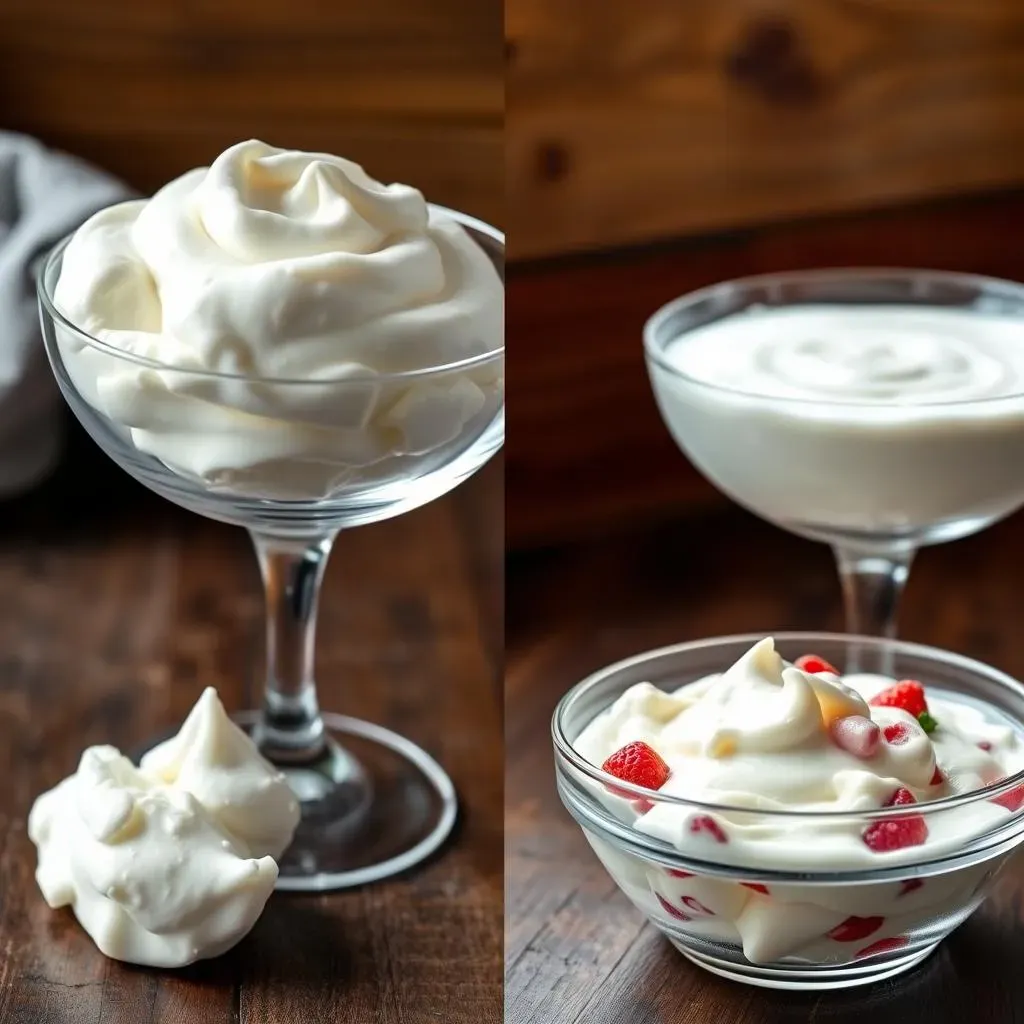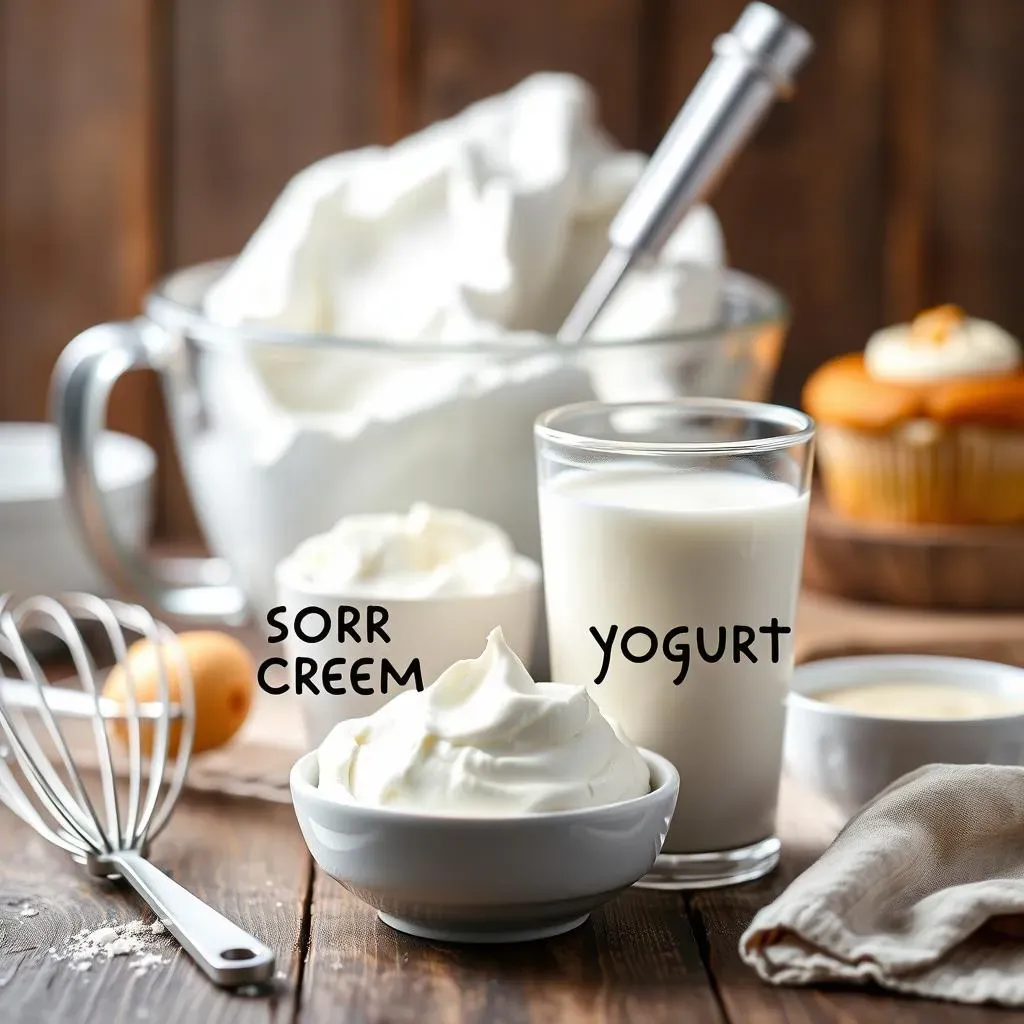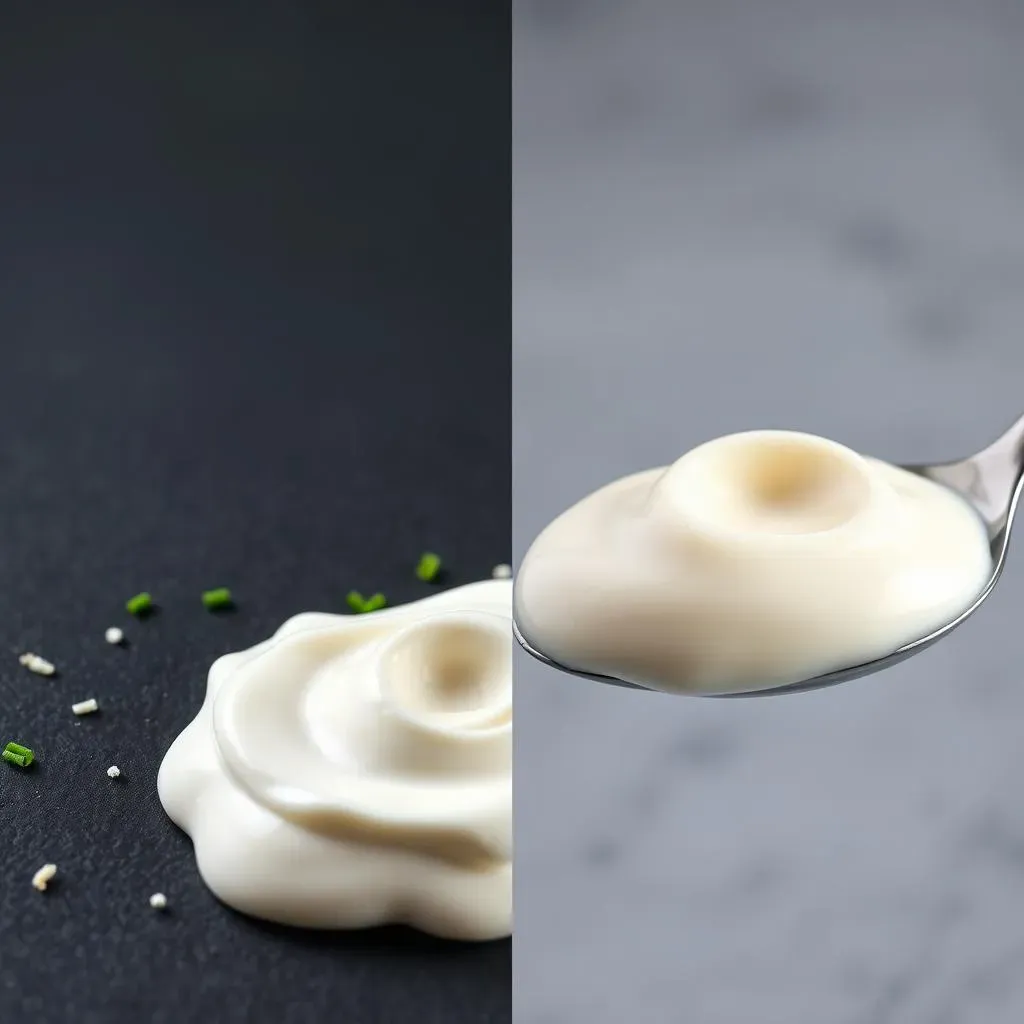Table of Contents
Ever stared blankly at a recipe, realizing you're missing a key ingredient – sour cream? And the only thing you have in your fridge is yogurt? Don't panic! This article tackles the burning question: "can I substitute sour cream for yogurt in a recipe?" We'll explore the subtle yet important differences between these two dairy delights, guiding you through successful substitutions. We'll examine how fat content and acidity play a role in your baking and cooking, providing recipe-specific advice. Learn to avoid common pitfalls like unexpected textures and off-flavors. Whether you're a seasoned chef or a kitchen novice, this guide will empower you to confidently swap sour cream for yogurt (or vice versa!) and achieve delicious results every time. Get ready to unlock a world of culinary flexibility!
Understanding the Differences: Sour Cream vs. Yogurt

Understanding the Differences: Sour Cream vs. Yogurt
Fat Content and Texture
Sour cream and yogurt, while both dairy products, differ significantly in their fat content and resulting texture. Sour cream generally boasts a higher fat percentage, leading to a richer, creamier consistency. This makes it ideal for applications where a luxurious mouthfeel is desired, such as in dips or as a topping for baked potatoes. Think of it like this: sour cream is the velvet robe of the dairy world, while yogurt is more like a comfortable cotton t-shirt.
Yogurt, on the other hand, can vary widely in fat content depending on the type. Greek yogurt, for instance, is known for its thickness and higher protein content, making it a sometimes suitable substitute for sour cream in certain recipes. However, regular yogurt tends to be thinner and less rich. This difference in texture can significantly impact the final product, especially in baking, where the richness of sour cream contributes to a moist crumb. For instance, substituting yogurt for sour cream in a cheesecake might result in a drier, less decadent dessert.
Dairy Product | Fat Content (approx.) | Texture |
|---|---|---|
Sour Cream | 18-30% | Thick, creamy |
Regular Yogurt | 0-2% | Thin to medium |
Greek Yogurt | 5-10% | Thick, creamy |
Acidity and Flavor Profile
The distinct tangy flavor of sour cream stems from its higher acidity. This sharpness adds a unique dimension to many dishes, cutting through richness and providing a pleasant contrast. The acidity also plays a crucial role in baking, reacting with other ingredients to create the desired texture and rise in baked goods. For example, the tang in sour cream coffee cake provides a delightful balance to the sweetness of the cake itself. If you're substituting yogurt, be mindful that the acidity levels may differ significantly. Buttermilk, for instance, is a much more acidic option.
Yogurt's acidity varies depending on the type and brand, ranging from mildly tart to almost sweet. Plain yogurt is generally the closest match in terms of flavor to sour cream, but it still lacks the same intensity of tang. This difference in acidity can affect the final product, particularly in recipes where the sour cream's tang is a key element. For instance, substituting yogurt for sour cream in a creamy tomato soup might result in a milder, less vibrant flavor profile. Consider the overall flavor profile of your recipe when deciding whether to swap sour cream for yogurt, or perhaps explore other sour cream alternatives.
- Sour cream: Sharper, more intense tang
- Plain Yogurt: Mildly tart to slightly sweet
- Greek Yogurt: Varies depending on brand and fat content.
Swapping in Yogurt: A RecipebyRecipe Guide

Swapping in Yogurt: A RecipebyRecipe Guide
Baking with Yogurt: Cakes and Muffins
Let's talk cakes and muffins! In many recipes, yogurt can be a surprisingly successful swap for sour cream. The higher protein content of Greek yogurt, in particular, can even help create a moister crumb. Remember though, the flavor profile will shift slightly. Sour cream offers a sharper tang, while yogurt tends to be milder. To compensate for this, you might want to add a touch of lemon juice or vinegar to mimic the sour cream's acidity. For example, in a recipe for sour cream coffee cake, you might find that substituting Greek yogurt results in a slightly less tangy, but still delicious, treat. The key is to experiment and see what works best for your taste preferences. Check out our guide on using Greek yogurt as a sour cream substitute for more ideas.
Don't be afraid to adjust other ingredients to fine-tune the final product. If your recipe calls for a lot of sugar, you might need to reduce the amount slightly when using yogurt, as it often has a slightly sweeter profile than sour cream. You can also add a pinch of salt to enhance the flavor and balance out the sweetness. If you are using a low-fat yogurt, you may want to add a little bit of oil or melted butter to compensate for the lack of fat. Always start with a small substitution and adjust based on the results. Remember, baking is all about experimentation, and finding the perfect balance between taste and texture is half the fun!
- Start with a 1:1 substitution.
- Adjust sugar and salt to taste.
- Add a little oil or melted butter if needed.
Savory Dishes: Sauces and Dips
Now, let's move on to the savory side of things! In many sauces and dips, yogurt can work remarkably well as a sour cream substitute, particularly if you're using a full-fat Greek yogurt. The creamy texture of Greek yogurt mimics sour cream's consistency quite well. However, the flavor difference will be more pronounced in savory dishes. If you’re making a creamy tomato soup and swap in yogurt, the finished product may lack that sharp tang that sour cream provides. You could try adding a squeeze of lemon juice or a dash of white wine vinegar to add some extra acidity. For a richer flavor, consider using full-fat Greek yogurt. For instance, in a recipe for tzatziki, a Greek yogurt-based sauce, the tanginess of the yogurt complements the cucumbers and garlic beautifully. But, in a creamy dill sauce, the lack of sour cream's sharp tang might be noticeable.
Consider the other ingredients in your recipe. If the recipe already has strong flavors (like spices or herbs), the difference in acidity between sour cream and yogurt might be less noticeable. If your recipe is more delicate in flavor, the substitution might be more apparent. If you're still unsure, it's always a good idea to start by making a small batch of your dish with the yogurt substitution and taste-testing it before making a larger quantity. Remember, culinary adventures are all about exploration and discovery! Need more ideas for sour cream swaps? Learn how to substitute sour cream for mayonnaise in some recipes.
Recipe Type | Yogurt Type | Flavor Adjustment |
|---|---|---|
Creamy Tomato Soup | Full-fat Greek | Lemon juice or vinegar |
Tzatziki | Full-fat Greek | None needed |
Creamy Dill Sauce | Full-fat Greek | Lemon juice or vinegar |
Beyond the Basics: Adjusting for Texture and Acidity
Sometimes, a simple 1:1 swap isn't enough to replicate the exact texture and taste of sour cream. Remember, sour cream is naturally thicker and tangier than most yogurts. If you're aiming for a closer match, consider thickening the yogurt before using it as a substitute. You can achieve this by straining the yogurt through cheesecloth for a few hours, allowing the whey to drain. This process will result in a thicker, creamier consistency that more closely resembles sour cream. For a quicker solution, you can mix a tablespoon of cornstarch with a few tablespoons of the yogurt before adding it to the recipe. This will help thicken the mixture as it cooks or bakes.
Don't forget about the acidity! If your recipe relies on the sharpness of sour cream, you might need to boost the acidity of your yogurt substitute. A simple trick is to add a teaspoon or two of lemon juice or white vinegar to the yogurt. Start with a small amount and taste as you go to avoid making the dish too sour. Again, this is all about experimenting and finding the perfect balance for your palate. The beauty of cooking is that there's always room for creative adjustments! Want to explore more creative alternatives? Check out our extensive guide on substituting sour cream for cottage cheese.
Remember, these are just guidelines. The best way to determine if a sour cream substitute works in your recipe is to experiment and taste test!
Beyond the Basics: Considering Fat Content and Acidity

Beyond the Basics: Considering Fat Content and Acidity
Fat Content: A Creamy Conundrum
Let's get down to the nitty-gritty: fat content is a major player in the sour cream versus yogurt debate. Sour cream typically boasts a higher fat percentage (around 18-30%), resulting in that luscious, thick texture we all love. This richness contributes significantly to the overall mouthfeel of dishes, making it a star ingredient in creamy soups, decadent dips, and rich frostings. Think of it as the luxurious velvet lining of your culinary creation.
Yogurt, on the other hand, is a much more diverse beast. Regular yogurt often has a much lower fat content (sometimes as low as 0%), leading to a thinner consistency. Greek yogurt, however, often bridges the gap, offering a thicker texture and higher protein content, making it a potentially better stand-in for sour cream in some applications. But even then, it rarely reaches the same richness as sour cream. For instance, substituting regular yogurt for sour cream in a creamy potato topping might result in a watery, less satisfying experience. To learn more about other substitutes for sour cream, check out our comprehensive guide on substituting sour cream for heavy cream.
Dairy Product | Approximate Fat Content (%) | Ideal Uses |
|---|---|---|
Sour Cream | 18-30 | Dips, toppings, frostings |
Regular Yogurt | 0-2 | Smoothies, marinades |
Greek Yogurt | 5-10 | Sauces, dips (sometimes) |
Acidity: The Tang Factor
Beyond fat content, acidity plays a crucial role in how sour cream and yogurt behave in recipes. Sour cream's characteristic tang comes from its higher acidity levels. This tartness isn't just about flavor; it also interacts with other ingredients, affecting texture and rise in baked goods. For example, in a sour cream coffee cake, the acidity contributes to a tender crumb and a delightful balance to the sweetness. If you're swapping in yogurt, be aware that its acidity is often milder, potentially leading to a less tangy final product. For example, substituting yogurt in a recipe that calls for sour cream might result in a less tangy final product.
The acidity level in yogurt varies widely depending on the type and brand. Plain yogurt is generally your best bet for a sour cream swap, but it still won't match sour cream's punchy tang. To compensate, you could add a touch of lemon juice or vinegar to your yogurt substitute to boost the acidity. However, be cautious—a little goes a long way! Overdoing it can make your dish unpleasantly sour. Remember, the goal is to mimic the overall flavor profile of the original recipe, not to create a completely new flavor experience. To explore other options, you can find our guide on substituting sour cream for buttermilk here.
- Sour cream: High acidity, sharp tang
- Plain Yogurt: Moderate acidity, mild tang
- Greek Yogurt: Variable acidity, often milder than sour cream
Troubleshooting Common Issues: Texture and Taste

Troubleshooting Common Issues: Texture and Taste
Too Thin? Too Thick? Texture Troubles
One common issue when substituting yogurt for sour cream is a difference in texture. Sour cream's higher fat content creates a richer, creamier consistency. If you're using regular yogurt, your final product might be thinner than expected. This is particularly noticeable in dips and sauces where a thick, creamy texture is desired. To combat this, consider using full-fat Greek yogurt, which offers a thicker consistency. Alternatively, you can thicken your yogurt by straining it through cheesecloth for a few hours to remove excess whey. This simple technique yields a much creamier result, closer to the texture of sour cream.
On the other hand, if you're using a very thick Greek yogurt, you might find your dish becomes too dense. In this case, you might need to thin it out slightly. A little milk or cream can do the trick, but start with a small amount and add more as needed. Remember, consistency is key, especially in recipes where a specific texture is crucial. For example, a thin sauce might not coat pasta properly, and a too-thick frosting could be difficult to spread. To learn more about achieving the perfect consistency, check out our guide on substituting sour cream for heavy cream in quiche, which often requires careful attention to texture.
- Use full-fat Greek yogurt for thicker consistency.
- Strain yogurt to remove whey for extra creaminess.
- Thin with milk or cream if needed.
Taste Test Triumphs and Tribulations
Another potential issue is the difference in taste. Sour cream possesses a distinctive tangy flavor that comes from its higher acidity. Yogurt, even plain yogurt, generally has a milder flavor profile. If your recipe relies heavily on the sharp tang of sour cream, a direct yogurt swap might result in a less flavorful dish. To address this, consider adding a touch of lemon juice, lime juice, or white vinegar to your yogurt substitute. These acidic ingredients will help replicate sour cream's characteristic tartness. Start with a small amount and taste-test as you go, adjusting to your preference. Remember, taste is subjective, so don't be afraid to experiment until you find the perfect balance!
Remember that the overall flavor profile of your recipe is crucial. If your dish already contains strong flavors—like spices, herbs, or other bold ingredients—the difference in acidity might be less noticeable. However, in more delicate recipes, a milder yogurt might lack the punch needed to complement the other flavors. In these cases, carefully consider the flavor balance and whether the yogurt substitution will truly enhance or detract from the overall taste. Need some more ideas for sour cream substitutes? Check out our guide on substituting sour cream for applesauce for some unique alternatives.
Issue | Solution |
|---|---|
Too mild flavor | Add lemon juice, lime juice, or vinegar |
Too bland | Add a pinch of salt or other spices |
Too sour | Add a touch of sugar or sweetener |